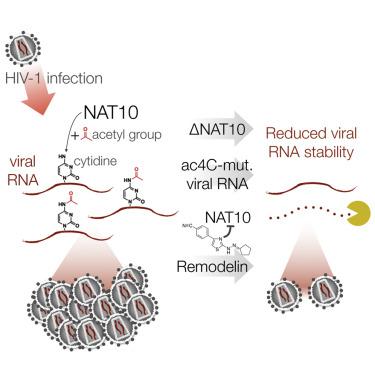Cell Host & Microbe ( IF 20.6 ) Pub Date : 2020-06-12 , DOI: 10.1016/j.chom.2020.05.011 Kevin Tsai 1 , Ananda Ayyappan Jaguva Vasudevan 1 , Cecilia Martinez Campos 1 , Ann Emery 2 , Ronald Swanstrom 3 , Bryan R Cullen 1

|
Epitranscriptomic RNA modifications, including methylation of adenine and cytidine residues, are now recognized as key regulators of both cellular and viral mRNA function. Moreover, acetylation of the N4 position of cytidine (ac4C) was recently reported to increase the translation and stability of cellular mRNAs. Here, we show that ac4C and N-acetyltransferase 10 (NAT10), the enzyme that adds ac4C to RNAs, have been subverted by human immunodeficiency virus 1 (HIV-1) to increase viral gene expression. HIV-1 transcripts are modified with ac4C at multiple discrete sites, and silent mutagenesis of these ac4C sites led to decreased HIV-1 gene expression. Similarly, loss of ac4C from viral transcripts due to depletion of NAT10 inhibited HIV-1 replication by reducing viral RNA stability. Interestingly, the NAT10 inhibitor remodelin could inhibit HIV-1 replication at concentrations that have no effect on cell viability, thus identifying ac4C addition as a potential target for antiviral drug development.
中文翻译:

胞苷残基的乙酰化通过增加病毒 RNA 稳定性来促进 HIV-1 基因表达。
表观转录组学 RNA 修饰,包括腺嘌呤和胞苷残基的甲基化,现在被认为是细胞和病毒 mRNA 功能的关键调节因子。此外,N 4 的乙酰化最近有报道称胞苷 (ac4C) 的位置可以增加细胞 mRNA 的翻译和稳定性。在这里,我们展示了 ac4C 和 N-乙酰转移酶 10 (NAT10)(将 ac4C 添加到 RNA 的酶)已被人类免疫缺陷病毒 1 (HIV-1) 颠覆以增加病毒基因表达。HIV-1 转录本在多个离散位点被 ac4C 修饰,这些 ac4C 位点的无声突变导致 HIV-1 基因表达降低。类似地,由于 NAT10 耗尽导致病毒转录本中 ac4C 的丢失通过降低病毒 RNA 稳定性来抑制 HIV-1 复制。有趣的是,NAT10 抑制剂 remodelin 可以在对细胞活力没有影响的浓度下抑制 HIV-1 复制,从而将 ac4C 添加确定为抗病毒药物开发的潜在目标。









































 京公网安备 11010802027423号
京公网安备 11010802027423号